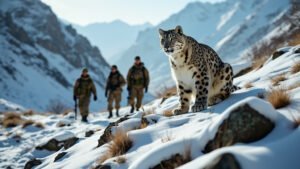Introduction
Wildlife corridors are essential tools in snow leopard conservation, helping to connect fragmented habitats and allowing these elusive big cats to roam freely across their vast mountainous range
This article explores the function of wildlife corridors, their specific benefits to snow leopard populations, and the key challenges faced in implementing these critical conservation pathways
We’ll examine the importance of habitat connectivity, how corridors influence snow leopard behavior, and the threats posed by human encroachment and climate change, providing insight into the ongoing efforts to protect these endangered animals
What Are Wildlife Corridors and How Do They Function?
Wildlife corridors are designated pathways that connect fragmented habitats, allowing animals to move safely between areas. These corridors play a crucial role in maintaining biodiversity by preventing isolated populations from becoming genetically inbred and ensuring species can access vital resources like food, water, and mates
They are especially important for wide-ranging species like snow leopards, which require vast territories in mountainous regions
The construction and maintenance of wildlife corridors can involve both natural and man-made elements, from protected mountain passes to human-managed routes designed to avoid human infrastructure and development
What Defines a Wildlife Corridor?
A wildlife corridor is any natural or constructed route that enables the safe passage of animals between fragmented areas of habitat. These routes can vary greatly in size and complexity, depending on the species they are designed to support and the geographical landscape
For snow leopards, a wildlife corridor might include mountainous passes, ridgelines, and valleys. The corridors must provide cover and adequate access to prey, ensuring that snow leopards can travel without unnecessary exposure to human activity, which increases the risk of poaching or human-wildlife conflicts
The design of an effective corridor also takes into account factors like the availability of prey, water sources, and vegetation, as well as minimal human interference. Corridors are often identified through extensive research and tracking of animal movements
Snow leopards, for instance, are tracked using GPS collars, allowing conservationists to map out their migration routes and identify critical areas for protection. Corridors are then designated based on these movement patterns and the suitability of the terrain for long-term conservation
Key Elements of Effective Wildlife Corridors
Several elements make a wildlife corridor effective for species like snow leopards. The first is connectivity, which refers to the ability of the corridor to link fragmented habitats in a way that allows safe and regular movement
For snow leopards, this means connecting valleys and mountain passes that might otherwise be cut off by human settlements or infrastructure like roads and railways. Corridors must also offer protection from human threats, which can range from poaching to vehicle collisions
Another crucial factor is the availability of prey. Snow leopards require abundant prey species, such as blue sheep and ibex, to sustain themselves, so corridors must traverse areas where prey populations are stable. The width of the corridor is also critical. If the passage is too narrow, it may not support regular movement or might expose the animal to greater risks of human detection
Finally, the terrain itself is important. Snow leopards thrive in rugged, high-altitude landscapes, and their corridors need to reflect that. Steep slopes and rocky outcrops provide both the physical challenge that suits their agility and the concealment needed for hunting and avoiding human threats
Wildlife Corridors in Mountainous Regions
In mountainous regions like the Himalayas and Central Asia, where snow leopards live, wildlife corridors often follow natural features of the landscape
Snow leopards are well adapted to these harsh environments, but human expansion into these regions is increasingly disrupting their ability to move freely. Mountain passes, ridgelines, and river valleys often serve as natural corridors for snow leopards, enabling them to move between different areas of their territory without crossing into human-dominated spaces
One of the most significant challenges in mountainous regions is the development of infrastructure like roads, which can fragment the snow leopard’s habitat and reduce the effectiveness of natural corridors. Projects such as the Trans-Himalayan Highway have been identified as a major threat to the continued movement of snow leopards
Conservation organizations are working to map out and protect critical corridors in these regions, ensuring that snow leopards can continue to thrive despite human expansion
How Do Wildlife Corridors Benefit Snow Leopard Populations?
Wildlife corridors play a critical role in snow leopard conservation by promoting habitat connectivity, which is essential for the survival of these large cats. Snow leopards roam vast territories in search of prey and mates, and habitat fragmentation caused by human development can severely limit their ability to sustain viable populations
Corridors ensure that snow leopards have safe passage between these territories, thereby reducing isolation and increasing genetic diversity. Additionally, corridors help snow leopards avoid human conflicts and access resources vital to their survival
Ensuring Habitat Connectivity for Snow Leopards
One of the primary benefits of wildlife corridors is the maintenance of habitat connectivity. Snow leopards typically inhabit remote and rugged mountain landscapes, but as human populations grow, these habitats are increasingly fragmented by roads, settlements, and infrastructure projects
Without corridors, snow leopards may find themselves trapped in isolated pockets of habitat, unable to move freely between regions to hunt or find mates. This isolation can lead to genetic bottlenecks, where inbreeding reduces genetic diversity and increases vulnerability to disease and environmental changes
Wildlife corridors serve as lifelines, linking fragmented habitats and allowing snow leopards to traverse areas they would otherwise avoid due to human presence. This not only ensures access to a larger pool of resources but also helps to prevent inbreeding by facilitating movement between populations
Studies have shown that snow leopards with access to well-maintained corridors have higher chances of survival and reproductive success, as they can move more freely across their vast ranges
Corridors and Snow Leopard Movement Patterns
Snow leopards are solitary animals with extensive home ranges that can span up to 500 square miles in the case of males. They are highly territorial and require large tracts of land to support their hunting and reproductive needs
Wildlife corridors play a pivotal role in facilitating their movement across these vast ranges, especially in areas where human encroachment has restricted their access to traditional migration routes
Research conducted by McCarthy et al. (2017) using GPS collar data has demonstrated that snow leopards frequently use wildlife corridors to navigate through fragmented landscapes. These corridors often follow natural features such as ridgelines, valleys, and river systems, which provide both cover and access to prey
In regions like the Himalayas and Central Asia, corridors allow snow leopards to cross between mountain ranges and avoid the risk of becoming confined to small, isolated territories
Snow leopards use these routes not only for migration but also for daily activities like hunting and patrolling their territory. By ensuring safe movement between critical habitats, wildlife corridors help snow leopards maintain their natural behaviors and survival strategies
Impact on Prey Availability and Hunting Areas
Another significant benefit of wildlife corridors is their role in ensuring that snow leopards have access to adequate prey. Snow leopards rely on a variety of prey species, such as blue sheep, ibex, and marmots, to meet their dietary needs
However, prey populations are often unevenly distributed across the landscape, and without access to different hunting areas, snow leopards may struggle to find enough food to survive
Wildlife corridors enable snow leopards to move between regions with varying prey densities, increasing their chances of successful hunts. In regions where prey populations fluctuate due to seasonal changes or human activities like poaching, corridors become especially vital
A study by Kachel et al. (2020) found that snow leopards using wildlife corridors had a more consistent access to prey, which contributed to their overall health and reproductive success
By providing access to diverse hunting grounds, wildlife corridors also help snow leopards maintain a balanced diet and avoid overhunting in any one area. This balance is crucial for both the snow leopard and the ecosystem, as it prevents the depletion of prey species and ensures the long-term sustainability of the habitat
Challenges in Establishing Wildlife Corridors for Snow Leopards
The establishment of wildlife corridors for snow leopards presents a range of challenges, from human encroachment to the impacts of climate change. These difficulties often complicate efforts to maintain connectivity between habitats and ensure the survival of snow leopard populations
Conservationists must navigate these obstacles while balancing the needs of local communities, international cooperation, and the long-term sustainability of snow leopard ecosystems
Human Encroachment and Infrastructure Development
Human encroachment is one of the most significant challenges to creating and maintaining effective wildlife corridors. As human populations expand into previously remote areas, the habitats of snow leopards are increasingly fragmented by roads, villages, and agricultural activities
Infrastructure projects, such as roads and hydroelectric dams, can create physical barriers that disrupt natural migration routes and isolate snow leopard populations
For instance, in the Himalayas and other parts of Central Asia, infrastructure projects aimed at improving transportation and economic development often cut through key snow leopard habitats. These developments hinder the movement of not only the snow leopards but also their prey, forcing the animals to alter their traditional routes and behaviors
Additionally, the presence of roads increases the risk of human-snow leopard conflicts, as leopards may come into closer contact with livestock and people
Mitigating the effects of human encroachment requires careful planning and collaboration between governments, local communities, and conservation organizations
Some strategies include the construction of wildlife overpasses or underpasses that allow snow leopards to safely cross roads, as well as the designation of protected zones where development is limited. However, the implementation of such measures often faces resistance due to the economic priorities of the region
Climate Change and Its Effects on Corridor Viability
Climate change poses another major threat to the effectiveness of wildlife corridors. As temperatures rise and weather patterns shift, the ecosystems that support snow leopards are also changing
Snow leopards are adapted to cold, high-altitude environments, and shifts in climate can affect the availability of prey, water sources, and suitable habitats. Warmer temperatures may push snow leopards to higher elevations, further limiting their range and increasing the need for well-placed corridors
In addition to altering the landscape, climate change can also lead to more frequent natural disasters, such as landslides and flooding, which can destroy existing corridors and prevent the creation of new ones
The unpredictability of these changes makes it difficult for conservationists to plan long-term solutions, as areas that are viable corridors today may not remain suitable in the future
Research conducted by Schaller et al. (2007) highlights the importance of adaptive management strategies in the face of climate change
This involves continuously monitoring snow leopard movements and adjusting conservation efforts to account for changing environmental conditions. By remaining flexible, conservation programs can better respond to the shifting needs of snow leopards and their habitats
International Conservation Efforts and Local Participation
The establishment of wildlife corridors often requires collaboration between multiple countries, as snow leopards roam across vast ranges that transcend national borders
International cooperation is crucial for ensuring that conservation efforts are coordinated and effective, particularly in regions where political tensions or economic disparities may complicate cross-border initiatives
Organizations like the Snow Leopard Trust and the Global Snow Leopard and Ecosystem Protection Program (GSLEP) work to facilitate these international efforts, bringing together governments, NGOs, and local communities to create unified strategies for snow leopard conservation
One of the key goals of these organizations is to establish a network of transboundary corridors that allow snow leopards to move freely between countries without facing human-imposed barriers
However, achieving this level of cooperation is not without its challenges. Political instability, differing conservation priorities, and limited funding can all hinder the progress of cross-border corridor initiatives
Additionally, gaining the support of local communities is essential for the success of these projects. In many snow leopard habitats, local people rely on the same resources that the leopards need, such as land for grazing livestock. Balancing the needs of wildlife with those of human communities requires building trust, providing economic incentives, and involving locals in the planning and management of conservation efforts
Conclusion
Wildlife corridors are vital to the conservation of snow leopards, ensuring that these elusive animals can move freely across fragmented habitats in search of prey and mates. By maintaining habitat connectivity, corridors help prevent the isolation of snow leopard populations, which is crucial for their genetic diversity and long-term survival
The benefits extend beyond simply facilitating movement; corridors also allow snow leopards to access a wider range of resources and reduce the risks associated with human-wildlife conflict
However, establishing and maintaining effective wildlife corridors is not without its challenges. Human encroachment, infrastructure development, and climate change all threaten the viability of these essential pathways
Successful conservation efforts depend on a combination of adaptive management, international cooperation, and the involvement of local communities. As conservationists continue to address these challenges, wildlife corridors will remain a cornerstone in efforts to protect snow leopards and ensure their survival in an increasingly fragmented world











